
Remote-Controlled Fan Regulator

This circuit allows for the adjustment of a fan's speed from a distance, such as from a couch or bed. It utilizes an infrared receiver module TSOP1738 to capture the infrared signals sent by a remote control. The circuit operates on a regulated 9V power supply. An AC mains voltage is reduced by transformer X1, providing a secondary output of 12V-0-12V. The output from the transformer is converted to DC using a full-wave rectifier made up of diodes D1 and D2, filtered by capacitor C9, and regulated by a 7809 voltage regulator to ensure a stable 9V output. Any button on the remote can be used to control the fan's speed. The pulses from the IR receiver module are sent as a trigger signal to timer NE555 (IC1) through LED1 and resistor R4. IC1 is configured as a monostable multivibrator, which delays the clock signal sent to the decade counter and driver IC CD4017 (IC2). Out of the ten outputs from the decade counter IC2 (Q0 through Q9), only five (Q0 through Q4) are utilized to manage the fan speed. The Q5 output is unused, while Q6 is designated for resetting the counter. Additionally, another NE555 timer (IC3) is also set up as a monostable multivibrator. The pulse width is controlled by a combination of one of the resistors R5 through R9 and capacitor C5. The output from IC CD4017 (IC2) is connected to resistors R5 through R9; when Q0 is high, capacitor C5 charges through resistor R5, and similarly for the other outputs. An optocoupler MCT2E (IC5) functions as a zero-crossing detector, providing trigger pulses to monostable multivibrator IC3 during the zero crossing phase. The opto-isolator MOC3021 (IC4) is used to drive the triac BT136. A snubber network composed of resistor R13 (47-ohm) and capacitor C7 (0.01 µF) is employed for triac BT136. As the pulse width decreases, the firing angle of the triac increases, resulting in a higher fan speed. Therefore, pressing any button on the remote control increases the fan speed. The circuit should be assembled on a general-purpose PCB and enclosed in a compact case to ensure that the infrared sensor can effectively receive signals from the remote transmitter.
This circuit is designed for remote control of fan speed, leveraging infrared technology to provide convenience and ease of use. The TSOP1738 infrared receiver is crucial for detecting signals from a standard remote control, while the step-down transformer ensures that the circuit operates safely at a lower voltage. The full-wave rectifier and voltage regulator ensure that the circuit receives a stable power supply, which is essential for reliable operation.
The NE555 timer IC is a versatile component used in various applications, and in this circuit, it serves as a monostable multivibrator to generate a timed output pulse. The combination of the NE555 timer and the decade counter CD4017 allows for the creation of a speed control mechanism that can vary the fan's speed based on the duration of the received pulses.
The use of an optocoupler as a zero-crossing detector is particularly beneficial in AC applications, as it allows for safe interfacing between the low-voltage control circuit and the high-voltage AC load. This isolation protects sensitive components from high voltage spikes and noise, enhancing the circuit's robustness.
The triac BT136 is selected for its capability to handle AC loads, and the snubber network ensures that voltage spikes do not damage the triac during operation. The design's flexibility allows for various fan speed settings, making this circuit suitable for different applications where fan speed control is desired.
Overall, this circuit exemplifies practical applications of timers, counters, and optoisolators in creating a user-friendly system for controlling electrical devices from a distance. Proper assembly on a PCB and housing in an appropriate case are essential for achieving optimal performance and ensuring safety during operation.Using this circuit, you can change the speed of the fan from your couch or bed. Infrared receiver module TSOP1738 is used to receive the infrared signal transmitted by remote control. The circuit is powered by regulated 9V. The AC mains is stepped down by transformer X1 to deliver a secondary output of 12V-0-12V. The transformer output is rectifie d by full-wave rectifier comprising diodes D1 and D2, filtered by capacitor C9 and regulated by 7809 regulator to provide 9V regulated output. Any button on the remote can be used for controlling the speed of the fan. Pulses from the IR receiver module are applied as a trigger signal to timer NE555 (IC1) via LED1 and resistor R4.
IC1 is wired as a monostable multivibrator to delay the clock given to decade counter-cum-driver IC CD4017 (IC2). Out of the ten outputs of decade counter IC2 (Q0 through Q9), only five (Q0 through Q4) are used to control the fan.
Q5 output is not used, while Q6 output is used to reset the counter. Another NE555 timer (IC3) is also wired as a monostable multivibrator. Combination of one of the resistors R5 through R9 and capacitor C5 controls the pulse width. The output from IC CD4017 (IC2) is applied to resistors R5 through R9. If Q0 is high capacitor C5 is charged through resistor R5, if Q1 is high capacitor C5 is charged through resistor R6, and so on. Optocoupler MCT2E (IC5) is wired as a zero-crossing detector that supplies trigger pulses to monostable multivibrator IC3 during zero crossing.
Opto-isolator MOC3021 (IC4) drives triac BT136. Resistor R13 (47-ohm) and capacitor C7 (0. 01 µF) combination is used as snubber network for triac1 (BT136). As the width of the pulse decreases, firing angle of the triac increases and speed of the fan also increases. Thus the speed of the fan increases when we press any button on the remote control. Assemble the circuit on a general-purpose PCB and house it in a small case such that the infrared sensor can easily receive the signal from the remote transmitter.
🔗 External reference
This circuit is designed for remote control of fan speed, leveraging infrared technology to provide convenience and ease of use. The TSOP1738 infrared receiver is crucial for detecting signals from a standard remote control, while the step-down transformer ensures that the circuit operates safely at a lower voltage. The full-wave rectifier and voltage regulator ensure that the circuit receives a stable power supply, which is essential for reliable operation.
The NE555 timer IC is a versatile component used in various applications, and in this circuit, it serves as a monostable multivibrator to generate a timed output pulse. The combination of the NE555 timer and the decade counter CD4017 allows for the creation of a speed control mechanism that can vary the fan's speed based on the duration of the received pulses.
The use of an optocoupler as a zero-crossing detector is particularly beneficial in AC applications, as it allows for safe interfacing between the low-voltage control circuit and the high-voltage AC load. This isolation protects sensitive components from high voltage spikes and noise, enhancing the circuit's robustness.
The triac BT136 is selected for its capability to handle AC loads, and the snubber network ensures that voltage spikes do not damage the triac during operation. The design's flexibility allows for various fan speed settings, making this circuit suitable for different applications where fan speed control is desired.
Overall, this circuit exemplifies practical applications of timers, counters, and optoisolators in creating a user-friendly system for controlling electrical devices from a distance. Proper assembly on a PCB and housing in an appropriate case are essential for achieving optimal performance and ensuring safety during operation.Using this circuit, you can change the speed of the fan from your couch or bed. Infrared receiver module TSOP1738 is used to receive the infrared signal transmitted by remote control. The circuit is powered by regulated 9V. The AC mains is stepped down by transformer X1 to deliver a secondary output of 12V-0-12V. The transformer output is rectifie d by full-wave rectifier comprising diodes D1 and D2, filtered by capacitor C9 and regulated by 7809 regulator to provide 9V regulated output. Any button on the remote can be used for controlling the speed of the fan. Pulses from the IR receiver module are applied as a trigger signal to timer NE555 (IC1) via LED1 and resistor R4.
IC1 is wired as a monostable multivibrator to delay the clock given to decade counter-cum-driver IC CD4017 (IC2). Out of the ten outputs of decade counter IC2 (Q0 through Q9), only five (Q0 through Q4) are used to control the fan.
Q5 output is not used, while Q6 output is used to reset the counter. Another NE555 timer (IC3) is also wired as a monostable multivibrator. Combination of one of the resistors R5 through R9 and capacitor C5 controls the pulse width. The output from IC CD4017 (IC2) is applied to resistors R5 through R9. If Q0 is high capacitor C5 is charged through resistor R5, if Q1 is high capacitor C5 is charged through resistor R6, and so on. Optocoupler MCT2E (IC5) is wired as a zero-crossing detector that supplies trigger pulses to monostable multivibrator IC3 during zero crossing.
Opto-isolator MOC3021 (IC4) drives triac BT136. Resistor R13 (47-ohm) and capacitor C7 (0. 01 µF) combination is used as snubber network for triac1 (BT136). As the width of the pulse decreases, firing angle of the triac increases and speed of the fan also increases. Thus the speed of the fan increases when we press any button on the remote control. Assemble the circuit on a general-purpose PCB and house it in a small case such that the infrared sensor can easily receive the signal from the remote transmitter.
🔗 External reference
Warning: include(partials/cookie-banner.php): Failed to open stream: Permission denied in /var/www/html/nextgr/view-circuit.php on line 713
Warning: include(): Failed opening 'partials/cookie-banner.php' for inclusion (include_path='.:/usr/share/php') in /var/www/html/nextgr/view-circuit.php on line 713





